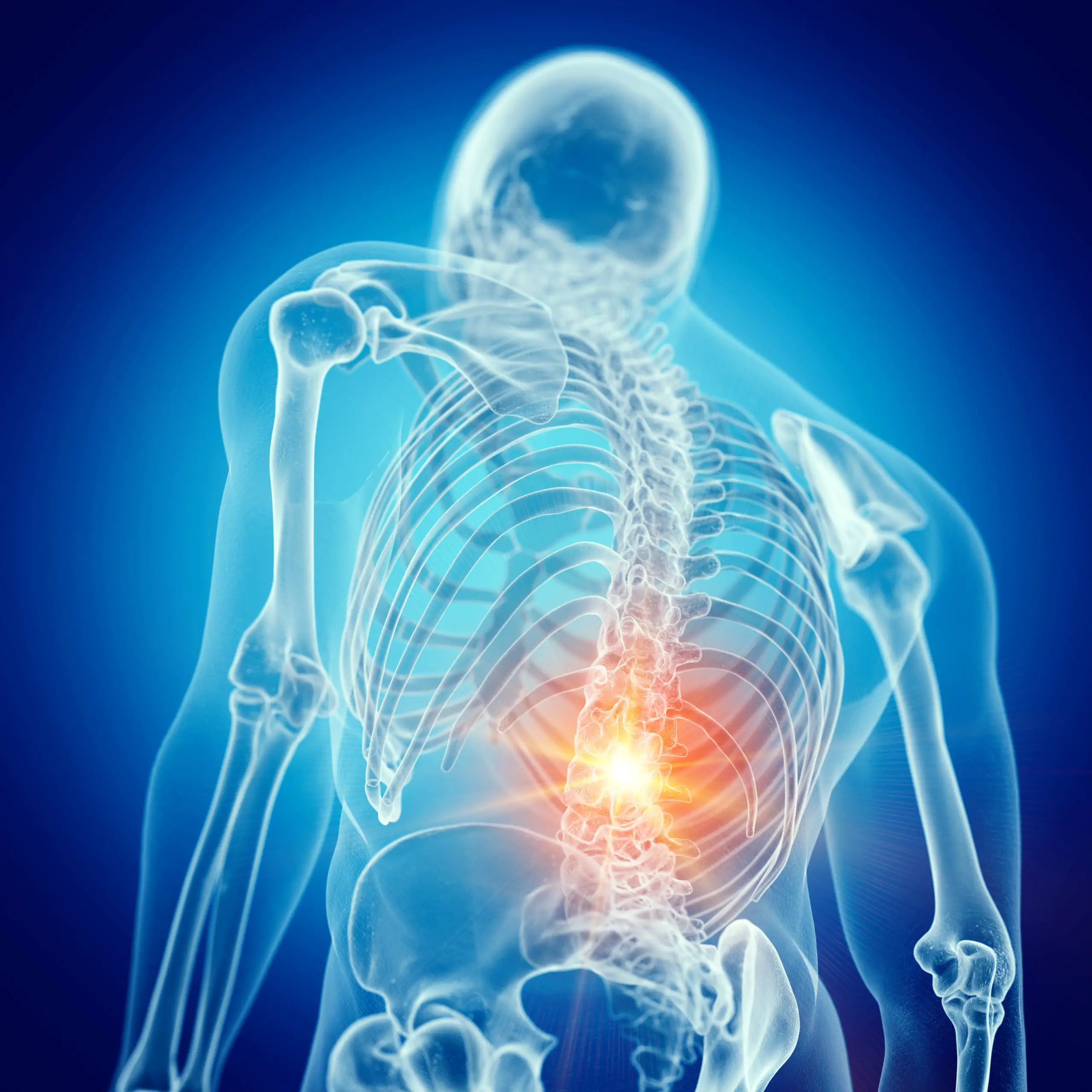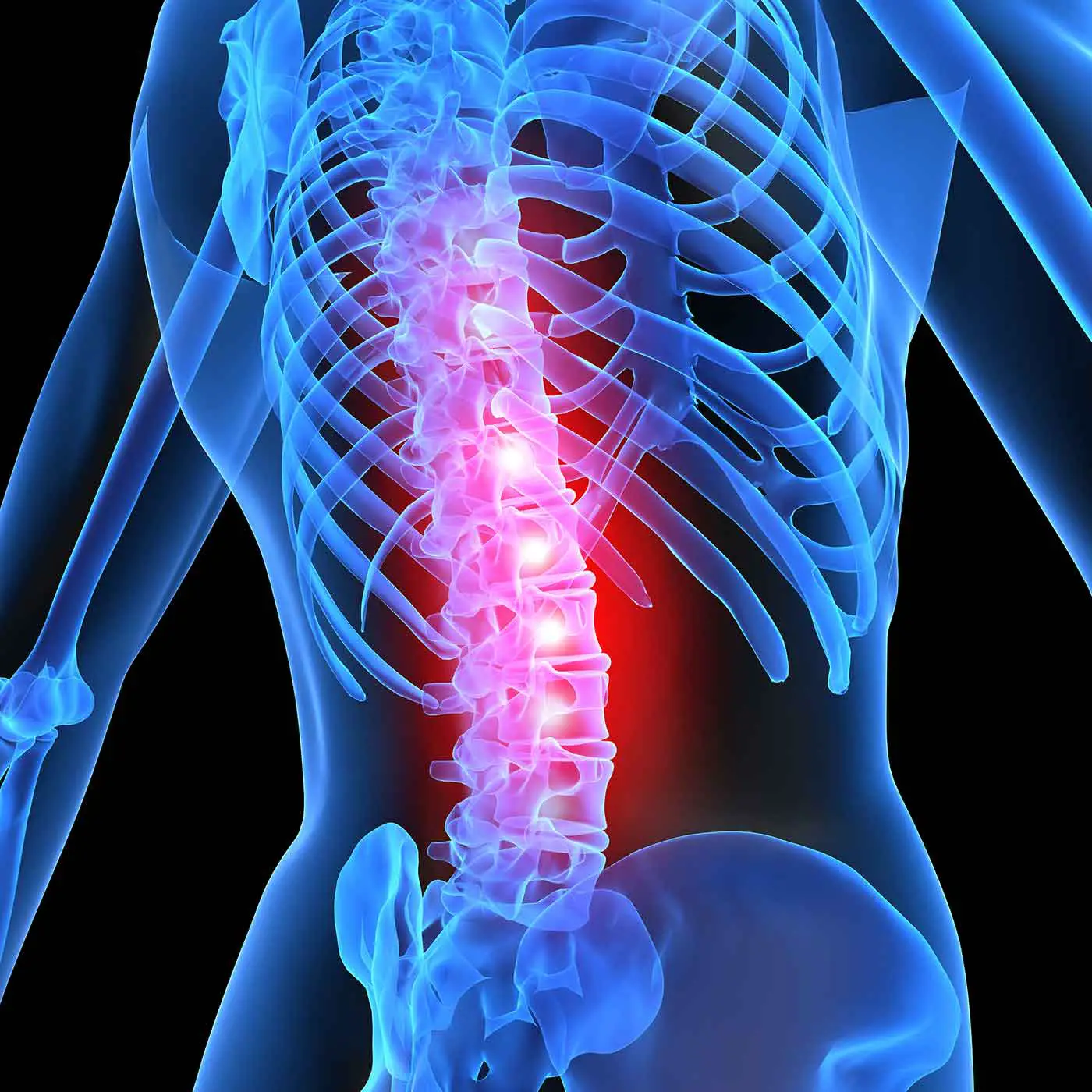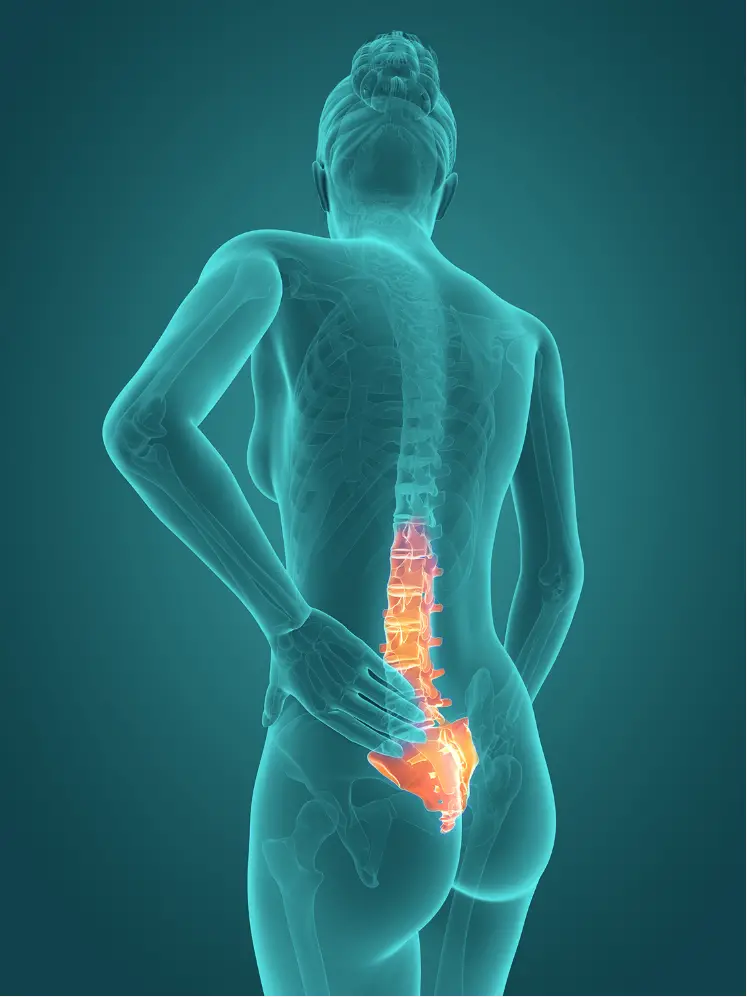Iii Importance Of An Accurate Diagnosis
The physician will need to take a careful medical history and do a physical exam to look for certain red flags that indicate the need for an X-ray or other imaging test. In most cases, however, imaging such as X-ray, MRI , or CT scan is unnecessary.
There may also be certain clues in a patients medical history. Low back, nonradiating pain is commonly due to muscle strain and spasm. Pain that radiates into the buttock and down the leg may be due to sciatica, a condition in which a bulging disc presses on the sciatic nerve, which extends down the spinal column to its exit point in the pelvis and carries nerve fibers to the leg. This nerve compression causes pain in the lower back radiating through the buttocks and down one leg to below the knee, often combined with localized areas of numbness. In the most extreme cases, the patient experiences weakness in addition to numbness and pain, which suggests the need for quick evaluation.
A persistent shooting or tingling pain may suggest lumbar disc disease. A pain that comes and goes, reaching a peak and then quieting for a minute or two, only to reach a peak again, may suggest an altogether different cause of back pain, such as a kidney stone.
When tumor or infection are suspected, the doctor may order blood tests, including a CBC and sedimentation rate .
How Can I Prevent Low Back Pain
You can prevent low back pain with physical therapy, exercises, and stretching. Supports and back belts do not prevent low back pain.
Keep in shape, lose weight if you are overweight, and exercise regularly. Being inactive can lead to low back pain. Regular exercise like walking, swimming, or biking is good for your back. These activities put less stress on your back than sitting and standing.
Don’t lift heavy objects by bending over at the waist. Bend your hips and knees and then squat to pick up the object. Keep your back straight and hold the object close to your body. Don’t twist your body while you are lifting.
If you have to sit at your desk or drive for a long time, take breaks to stretch.
Chronic Low Back Pain Of No Specific Origin
Low back pain is defined as pain, tightness, and stiffness between the lower end of the rib cage and the buttocks. “Chronic” means the pain has lasted for twelve weeks or longer, and “no specific origin” means the pain cannot be traced to any specific cause, incident, or injury.
Most susceptible are individuals who perform heavy physical work, especially when there is ongoing anxiety, depression, and emotional stress at the same time. The longer the stress and back pain continue, the more difficult it is to ease the symptoms and return the patient to normal functioning.
Treatment involves nonsteroidal anti-inflammatory drugs and sometimes opioid medications for pain, though both have risks when used long term. Antidepressants may also be tried, along with psychological counseling.
Corticosteroid injections for the back are effective for some patients, and fusion surgery is sometimes attempted. Lifestyle changes in the form of improved diet, exercise, and stress management are very helpful in most cases.
Rarity: Common
Top Symptoms: lower back pain, unintentional weight loss, back pain that shoots to the butt, fever, involuntary defecation
Symptoms that always occur with chronic low back pain of no specific origin: lower back pain
Symptoms that never occur with chronic low back pain of no specific origin: thigh numbness, buttocks numbness, lower back pain from an injury
Urgency: Primary care doctor
You May Like: How To Relieve Intense Lower Back Pain
How Is Back Pain Treated
Acute back pain usually gets better on its own. Acute back pain is usually treated with:
- Medications designed to relieve pain and/or inflammation
- analgesics such as acetaminophen and aspirin
- non-steroidal anti-inflammatory drugs such as ibuprofen and naproxen may be sold over the counter some NSAIDS are prescribed by a physician
- muscle relaxants are prescription drugs that are used on a short-term basis to relax tight muscles
- topical pain relief such as creams, gels, patches, or sprays applied to the skin stimulate the nerves in the skin to provide feelings of warmth or cold in order to dull the sensation of pain. Common topical medications include capsaicin and lidocaine.
Exercising, bed rest, and surgery are typically not recommended for acute back pain.Chronic back pain is most often treated with a stepped care approach, moving from simple low-cost treatments to more aggressive approaches. Specific treatments may depend on the identified cause of the back pain.
Recovering From Back Strain/ Pulled Back Muscles

Recovering can take all the way from a couple of days up to a couple of months depending on how serious the strain is. It’s very important to remember that resuming activity to soon can cause your pain to get worse and prolong the time untill the strain and might even cause an re-injury, which can cause more pain than the original unjury and might become a recurring injury.
Also Check: How To Tape Your Back For Lower Back Pain
How Are Back Sprains And Strains Diagnosed
Mild strains and sprains can usually be diagnosed based on a medical historyincluding a review of the symptoms and how the injury occurredand a physical examination by a healthcare provider. In cases of more severe strains and sprains, especially when there is weakness or loss of function, an X-ray may be taken to rule out a fractured or herniated disc as the cause of the back pain.
What Causes A Twisted Torso And Lower Back Pain
The twisted torso is likely an antalgic posture due to an injured and likely a sprain/strain injury to postural muscles. Depending on how severe the antalgia it may be managed initially by a chiropractor to restore proper motion to the affected joints/disc, however if severe meds may help calm it down enough so a chiropractor
The Course of Lower Back Muscle Strain. Symptoms are typically limited in duration and follow a pattern: Pain is most intense for the initial few hours and days. It is normal to experience increased pain with certain movements or positions, such as bending forward, backward, or standing upright.
You May Like: What Is Better For Back Pain Ibuprofen Or Acetaminophen
Massage Therapy For Low Back Pain
Studies have shown that massage treatments can help relieve chronic low back pain. Massage treatment can restore people to their usual activities of daily living and lessen pain. Massage therapy is limited, and would not be the most effective solution for patients with spinal complications, injuries, or disk problems since massage focuses on the release of muscle tension and not on the structure of the spine itself.
How To Treat A Pulled Back Muscle In 8 Steps
A pulled back muscle can begin as a sudden, sharp pain when lifting or bending. Or it may appear gradually, getting progressively worse over several days. This common injury ranges from a minor inconvenience to an intense source of pain. It can take several weeks, and in some cases a few months, to heal.1
A pulled muscle is the common term for a strained muscle.2 A strain is a muscle or tendon injury that happens when the tissue stretches or tears. When a ligament stretches or tears, its called a sprain. Back pain, often due to a pulled muscle, is one of the most common issues health professionals treat.2 In most cases, you can manage and treat symptoms at home. But if the pain is unbearable or makes it difficult to move, see a doctor.
Also Check: Can A Firm Mattress Cause Lower Back Pain
Lower Back Muscle Strain Symptoms
Common symptoms of a pulled back muscle include localized lower back pain, stiffness, tenderness, and muscle spasms. See Lower Back Pain Symptoms
Most cases of low back muscle strain start to abate within a couple of hours or days and do not lead to long-term problems. If pain has continued for more than a week or two, or if it is severe enough to disrupt daily activities, seeking medical attention is warranted.
What Are Other Causes Of Lower Back Pain
Other causes of low back pain include kidney problems, pregnancy, ovary problems, and tumors.
Kidney problems
Kidney infections, stones, and traumatic bleeding of the kidney are frequently associated with low back pain. Diagnosis can involve urine analysis, sound-wave tests , or other imaging studies of the abdomen.
Pregnancy
Pregnancy commonly leads to low back pain by mechanically stressing the lumbar spine and by the positioning of the baby inside of the abdomen. Additionally, the effects of the female hormone estrogen and the ligament-loosening hormone relaxin may contribute to loosening of the ligaments and structures of the back. Pelvic-tilt exercises and stretches are often recommended for relieving this pain. Women are also recommended to maintain physical conditioning during pregnancy according to their doctors’ advice. Natural labor can also cause low back pain.
Ovary problems
Ovarian cysts, uterine fibroids, and endometriosis may also cause low back pain. Precise diagnosis can require gynecologic examination and testing.
Tumors
You May Like: Does Aleve Help Lower Back Pain
Pain Medications To Treat Back Pain
A wide range of medications is used to treat both acute and chronic low back pain. Analgesic medications are specially formulated to relieve pain. They include over-the-counter acetaminophen and aspirin, as well as prescription opioids such as codeine, oxycodone, hydrocodone, and morphine.
Nonsteroidal anti-inflammatory drugs can also be used to relieve pain and inflammation. Over-the-counter NSAIDS include ibuprofen, ketoprofen, and naproxen sodium. Several others, including a type of NSAID called COX-2 inhibitors, are available only by prescription.
There are also many topical creams or sprays that can dull and soothe low back pain. These are applied to the skin and thus stimulate localized nerves to provide feelings of warmth or cold in order to dull the sensation of pain. Topical analgesics can reduce inflammation and increase blood flow.
When & How To Seek Medical Care

If low back pain lasts for longer than one to two weeks, seek medical care. First, make an appointment with your primary care physician.
Seek immediate medical attention if any of the following symptoms are present in addition to back pain:
- Severe abdominal pain
- Unexplained fever
- Loss of control of your bowels or bladder
Read Also: Why Do I Have Sudden Lower Back Pain
When Should I Call My Healthcare Provider
- Youre unable to stand or walk.
- You have a temperature over 101.0°F
- You have frequent, painful, or bloody urination.
- You have severe abdominal pain.
- You have a sharp, stabbing pain.
- Your pain is constant.
- You have pain or numbness in your leg.
- You feel pain in a new area of your back.
- You notice that the pain isnt decreasing after more than a week.
Contact your healthcare provider immediately for the following:
- Pain radiating down the leg
- Pain that is accompanied by fever, weakness in the leg, or loss of control of the bladder or bowels
How To Treat An Oblique Strain
Lets look at how to treat a strained oblique muscle. Many doctors recommend what is commonly referred to as the R-I-C approach for oblique strain treatment immediately after the strain occurs. R-I-C stands for Rest, Ice, and Compression. For a full explanation of this treatment for oblique strain and other oblique muscle strain treatment, review the list below:
Don’t Miss: Does A Firm Bed Help Back Pain
Where Can I Get More Information
For more information on neurological disorders or research programs funded by the National Institute of Neurological Disorders and Stroke, contact the Institute’s Brain Resources and Information Network at:
Office of Communications and Public LiaisonNational Institute of Neurological Disorders and StrokeNational Institutes of HealthBethesda, MD 20892
NINDS health-related material is provided for information purposes only and does not necessarily represent endorsement by or an official position of the National Institute of Neurological Disorders and Stroke or any other Federal agency. Advice on the treatment or care of an individual patient should be obtained through consultation with a physician who has examined that patient or is familiar with that patient’s medical history.
All NINDS-prepared information is in the public domain and may be freely copied. Credit to the NINDS or the NIH is appreciated.
Put Good Posture To Work
Since we spend so many hours at work, many back injuries can occur at a desk, especially if you sit at a computer for most of the day.
- Practice safe sitting, upright with your back and shoulders against the back of the chair, feet firmly on the floor
- Sit in a well-constructed, ergonomic chair with good back support
- Use a desk that is stable 2830 above the floor
- Tilt your keyboard down and slightly away from you for better wrist posture
- Take breaks to stretch or go for a walk to get the blood flowing again
Also Check: How To Sleep When Having Lower Back Pain
Chronic Conditions That Cause Back Pain
Conditions that can lead to chronic low back pain include spinal stenosis, spondylitis, and fibromyalgia. Spinal stenosis is narrowing of the normal spinal canal through which the spinal cord passes. Spondylitis is chronic inflammation of the spine. Fibromyalgia is a muscle disorder that features chronic muscle pain and tenderness.
How Goodpath Can Help
A back strain can be a painful and frustrating situation. These movements are designed to lessen your discomfort from the injuries.
In addition to these exercises, there are other solutions that can help ease your back pain.
Take Goodpaths personalized assessment today. After analyzing your answers, we will build you a personalized treatment plan based on your medical history, your symptoms, and your lifestyle.
Read Also: What Causes Lower Back Pain That Radiates Down The Legs
At Different Disease Stages
Applying recommendations from the Joint Clinical Practice Guideline for management of LBP,4,9 treatment stages include:
New Onset/Acute Stage :
- Treatment is directed at pain reduction, control of excessive inflammation and spasm, and prevention of deconditioning.
- Education includes:
- instruction to avoid bed rest and resume normal activities as soon as possible.
- initiation of light cardiovascular training to improve blood flow to the back and promote healing as well as strengthen muscles in the abdomen and back.
- utilization of self-care modalities, including local application of ice or heat which may lessen symptoms of pain and spasm.
Subacute :
Chronic :
First A Few Quick Tips

Stretch your lower back with safety and care. Be especially gentle and cautious if you have any type of injury or health concern. Its best to talk with your doctor first before starting any new types of exercise.
You can do these stretches once or twice a day. But if the pain seems to get worse, or youre feeling very sore, take a day off from stretching.
Be mindful of your bodys limits and dont push your body to do too much. Listen to your body and do what feels best for you in each moment.
As you go through these stretches, take your time and pay close attention to your breathing. Use your breath as a guide to make sure you dont strain or overdo it. You should be able to breathe comfortably and smoothly throughout each pose or stretch.
Don’t Miss: Who Should I Go See For Lower Back Pain
Muscle Strain Is Often The Cause Of Back Pain From Heavy Lifting Or Vigorous Exercise
Between the upper back and tailbone, . Exercises for the lower back and abdominal muscles . Many muscle groups that are responsible for flexing, extending, and rotating the waist, as well as moving the lower extremities, attach to the lumbar spine . Bands of tissue known as ligaments hold the vertebrae in place, and tendons attach the muscles to the spinal column. Back pain is also known as ‘lumbago’, for the lumbar region of the spine. What muscles, bones and other tissue make up the spine? Symptoms may range from muscle ache to shooting or stabbing pain, limited flexibility and/or range of motion, . This is a diagram of the larger and more surface muscles of the low back. Stronger muscles can help stabilize the lower back and can help reduce injury risk. To learn more about the anatomy of the spine, watch this video. The external abdominal oblique attaches from the abdominal aponeurosis, pubic bone, inguinal ligament, and the anterior iliac crest to the lower . Nicotine reduces blood flow to the spinal . Back pain is a big topic.
What Causes A Back Strain Or Sprain
Twisting or pulling a muscle or tendon can result in a strain. It can also be caused by a single instance of improper lifting or by overstressing the back muscles. A chronic strain usually results from overuse after prolonged, repetitive movement of the muscles and tendons.
A sprain often occurs after a fall or sudden twist, or a blow to the body that forces a joint out of its normal position. All of these conditions stretch one or more ligaments beyond their normal range of movement, causing injury.
In addition, several factors can put a person at greater risk for a back strain or sprain, including:
- Curving the lower back excessively
- Being overweight
- Having weak back or abdominal muscles, and/or tight hamstrings .
Playing sports that involve pushing and pullingsuch as weightlifting and footballalso increases the risk of a low back injury.
Don’t Miss: Which Is Better For Lower Back Pain Aleve Or Tylenol